It looks like you're using an Ad Blocker.
Please white-list or disable AboveTopSecret.com in your ad-blocking tool.
Thank you.
Some features of ATS will be disabled while you continue to use an ad-blocker.
share:
First off, a familiar depiction with a somewhat 'new' comparison ... just to set the 'mood'
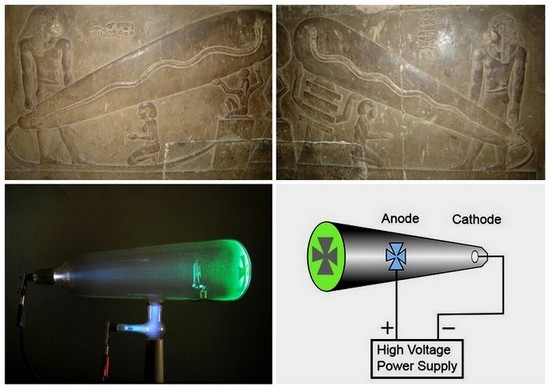 Top: Dendera, Bottom:
Crookes Tube
Top: Dendera, Bottom:
Crookes Tube
Do the depicitions above show something that the ancient Egyptians actually 'used' or rather something they just saw and couldn't interpret correctly? Was it just symbolic? Fact is: we don't know ... and that's true for many things regarding ancient Egypt, so we need to ask more questions and dig deeper! I discovered in many threads, though, that those who actually challenge traditional findings are frequently confronted with questions like: Which source did you use? Where's the evidence? Who said that? ... just to end up with a comment like: "That's not legit!" etc.
So I decided to present 3 key arguments that are derived from critical, well-researched papers & analyses. They point to alternative explanations as to how advanced the ancient Egyptians must have been & provide a different view on dating 'some' of the architecture at Giza.
----------------------------
NOTE: The Point of this post is not to present something completely new (it's all been out there for quite a while) but rather to have it all in one place/thread and encourage further discussion based on these documents.
... so here we go:
Argument 1: Ancient Egyptians used circular saws & lathes and a variety of other advanced tools to cut stone

Source: The Pyramids and Temples of Gizeh, Pages 173 - 177 (Online Version, PDF - 18mb)
by Sir William M. Flinders Petrie (Egyptologist)
Excerpt:
Ironically, it was indeed Flinders Petrie, an early Egyptologist and pioneer of systematic methodology in archaeology, who noticed that something about the stonework found around the Giza plateau wasn't right.
It's good to know that even back in the 1870s & 1880s, people were asking the same questions about the remarkable tools the ancient Egyptians must have used. For a more modern interpretation of how 'precise' the artifacts at Giza have been manufactured, I also recommend this article by Chris Dunn (very thought-provoking, though it's not an 'academic' essay).
----------------------------
Argument 2: Evidence suggests the use of 'ancient concrete' via reconstituted limestone blocks at Giza
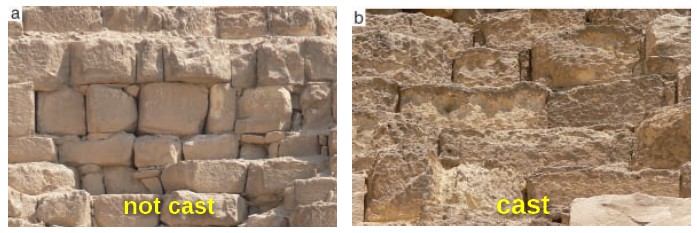
Source: Microstructural Evidence of Reconstituted Limestone Blocks in the Great Pyramids of Egypt (PDF, 761kb) by M. W. Barsoum and A. Ganguly (Department of Materials Science and Engineering, Drexel University, Philadelphia, Pennsylvania)
Excerpt:
The argument for the use of ancient concrete in the Great Pyramids had been heavily critized. Zahi Hawass insisted that the samples were taken from concrete fill-ins & blocks that were used in the past to repair the Pyramids. ETA: Seriously? Did Barsoum & Davidovits risk their academic reputation for 'contemporary' concrete in their analysis? Wouldn't they have easily recognized that as specialists in material sciences?
Oh yes ... and then there's also been a sea-shell-fossil discussion (found in the limestone) to rule out an artificial casting of the stones, here's a link if you're interested how that could be explained.
As of yet, the 'ancient concrete' theory cannot be dismissed and requires further consideration.
(continues in next post)

Do the depicitions above show something that the ancient Egyptians actually 'used' or rather something they just saw and couldn't interpret correctly? Was it just symbolic? Fact is: we don't know ... and that's true for many things regarding ancient Egypt, so we need to ask more questions and dig deeper! I discovered in many threads, though, that those who actually challenge traditional findings are frequently confronted with questions like: Which source did you use? Where's the evidence? Who said that? ... just to end up with a comment like: "That's not legit!" etc.
So I decided to present 3 key arguments that are derived from critical, well-researched papers & analyses. They point to alternative explanations as to how advanced the ancient Egyptians must have been & provide a different view on dating 'some' of the architecture at Giza.
----------------------------
NOTE: The Point of this post is not to present something completely new (it's all been out there for quite a while) but rather to have it all in one place/thread and encourage further discussion based on these documents.
... so here we go:
Argument 1: Ancient Egyptians used circular saws & lathes and a variety of other advanced tools to cut stone

Source: The Pyramids and Temples of Gizeh, Pages 173 - 177 (Online Version, PDF - 18mb)
by Sir William M. Flinders Petrie (Egyptologist)
Excerpt:
No. 6, a slice of diorite bearing equidistant and regular grooves of circular arcs, parallel to one another; these grooves have been nearly polished out by crossed grinding, but still are visible. The only feasible explanation of this piece is that it was produced by a circular saw.
And when we find on the surfaces of the saw-cuts in diorite, grooves as deep as 1/100 inch, it appears far more likely that such were produced by fixed jewel points in the saw, than by any fortuitous rubbing about of a loose powder. And when, further, it is seen that these deep grooves are almost always regular and uniform in depth, and equidistant, their production by the successive cuts of the jewel-teeth of a saw appears to be beyond question (...)
The great pressure needed to force the drills and saws so rapidly through the hard stones is very surprising; probably a load of at least a ton or two was placed on the 4 inch drills cutting in granite (...)
The principle of rotating the tool was, for sma!ler objects, abandoned in favour of rotating the work; and the lathe appears to have been as familiar an instrument in the fourth dynasty, as it is in modern workshops. The diorite bowls and vases of the Old Kingdom are frequently met with, and show great technical skill (...)
That no remains of these saws or tubular drills have yet been found is to be expected, since we have not yet found even waste specimens of work to a tenth of the amount that a single tool would produce; and the tools, instead of being thrown away like the waste, would be most carefully guarded (...)
Ironically, it was indeed Flinders Petrie, an early Egyptologist and pioneer of systematic methodology in archaeology, who noticed that something about the stonework found around the Giza plateau wasn't right.
It's good to know that even back in the 1870s & 1880s, people were asking the same questions about the remarkable tools the ancient Egyptians must have used. For a more modern interpretation of how 'precise' the artifacts at Giza have been manufactured, I also recommend this article by Chris Dunn (very thought-provoking, though it's not an 'academic' essay).
----------------------------
Argument 2: Evidence suggests the use of 'ancient concrete' via reconstituted limestone blocks at Giza

Source: Microstructural Evidence of Reconstituted Limestone Blocks in the Great Pyramids of Egypt (PDF, 761kb) by M. W. Barsoum and A. Ganguly (Department of Materials Science and Engineering, Drexel University, Philadelphia, Pennsylvania)
Excerpt:
We believe (...) that our work presents enough evidence to entertain the possibility that crucial parts of the Great Pyramids are indeed made of reconstituted limestone; only more research will tell. The conclusions reached herein, if confirmed by others on larger samples, clearly show that the Ancient Egyptians were not only exceptional civil and architectural engineers but also superb chemists and material scientists. They would also have to be credited with the invention of concrete, thousands of years before the Romans.
That a lime-based cement cast and cured at room temperature would survive for 5000 years — while the best our civilization has to offer, Portland cement, which under the best of circumstances lasts 150 years or less — is both awe inspiring and humbling. Lastly, we note that the full implications of our conclusions to history, in general, and Egyptology, in particular, have not escaped us.
The argument for the use of ancient concrete in the Great Pyramids had been heavily critized. Zahi Hawass insisted that the samples were taken from concrete fill-ins & blocks that were used in the past to repair the Pyramids. ETA: Seriously? Did Barsoum & Davidovits risk their academic reputation for 'contemporary' concrete in their analysis? Wouldn't they have easily recognized that as specialists in material sciences?
Oh yes ... and then there's also been a sea-shell-fossil discussion (found in the limestone) to rule out an artificial casting of the stones, here's a link if you're interested how that could be explained.
As of yet, the 'ancient concrete' theory cannot be dismissed and requires further consideration.
(continues in next post)
edit on 1-7-2013 by jeep3r because: text
Argument 3: Some of the structures at Giza, notably the Great Sphinx, are much older than previously thought

Source: Redating the Great Sphinx of Giza (article link) by Robert M. Schoch (PhD Geology and Geophysics, Yale University)
Excerpt
I personally believe Robert Schoch nails it with his analysis of the wheathering of the Great Sphinx, its enclosure & the surrounding structures. And when looking at the bigger picture, we might really have to assume that construction activities at Giza took place much earlier than previously thought. If we take all of the above sources into account, I think it's not unreasonable to assume that the ancient Egyptians were far more advanced than we give them credit for and/or that the origins of what has all been attributed to the ancient Egyptians might indeed reach back much further.
Of course, we could now go on and ask what was the 'purpose' of the Pyramids & their special layout? Why were they designed like that? Were they really just tombs? What about the shafts and Gantenbrink's door? For now, we can only speculate about that ... but as more & more specialists from other disciplines look into this, I'm sure we'll soon have some good & well-researched answers. And in the meantime, we can use the above references to 'justify' some of our uncomfortable questions ...
*All Images used above are either Public Domain, Creative Commons or have otherwise been referenced & sufficiently downsized

Source: Redating the Great Sphinx of Giza (article link) by Robert M. Schoch (PhD Geology and Geophysics, Yale University)
Excerpt
If the Great Sphinx of Giza was weathered heavily, and at an early period in its existence, by precipitation, this suggests that it initially may have been carved prior to the last great period of major precipitation in this part of the Nile Valley. Egypt was subjected to erratic floods and what is sometimes referred to as the "Nabtian Pluvial" (a period of relatively heavy rainfall) from 12,000 or 10,000 to about 5,000 years ago; and it has been suggested that there were sporadic but relatively heavy rains during the Fourth Millennium (4000 to 3000 B.C.).
(...) As far as can be determined, the core of the Sphinx Temple (and possibly the core of the Valley Temple) is constructed out of titanic limestone blocks taken directly from the ditch around the Sphinx.[11]Therefore, the limestone core of the Sphinx Temple (and also possibly the Valley Temple) must be as old as the great sculpture itself (...)
I am currently estimating -based on evidence at hand- that the origin of the colossal sculpture can be traced to at least 7000 to 5000 B.C., and perhaps even earlier. Of course, the Sphinx may not have looked like it does today some 8,000 years ago. The original surface details of the body have weathered away in the distant past, and the current head of the figure -which everyone agrees- is almost surely the result ot recarving.
I personally believe Robert Schoch nails it with his analysis of the wheathering of the Great Sphinx, its enclosure & the surrounding structures. And when looking at the bigger picture, we might really have to assume that construction activities at Giza took place much earlier than previously thought. If we take all of the above sources into account, I think it's not unreasonable to assume that the ancient Egyptians were far more advanced than we give them credit for and/or that the origins of what has all been attributed to the ancient Egyptians might indeed reach back much further.
Of course, we could now go on and ask what was the 'purpose' of the Pyramids & their special layout? Why were they designed like that? Were they really just tombs? What about the shafts and Gantenbrink's door? For now, we can only speculate about that ... but as more & more specialists from other disciplines look into this, I'm sure we'll soon have some good & well-researched answers. And in the meantime, we can use the above references to 'justify' some of our uncomfortable questions ...
*All Images used above are either Public Domain, Creative Commons or have otherwise been referenced & sufficiently downsized
edit on 1-7-2013 by jeep3r because: formatting
reply to post by jeep3r
Check this documentary out.
About 6 minutes in there's a part with John Anthony West.
He says he asked an oxford geologist if he could tell the difference between wind erosion and water erosion.
Of course he masked the head and paws of the sphynx.
And the geologist said that was water erosion.
Check out the video. Shoch is in the video as well.
Check this documentary out.
About 6 minutes in there's a part with John Anthony West.
He says he asked an oxford geologist if he could tell the difference between wind erosion and water erosion.
Of course he masked the head and paws of the sphynx.
And the geologist said that was water erosion.
Check out the video. Shoch is in the video as well.
edit on 1-7-2013 by grey580 because: (no reason given)
reply to post by grey580
Thanks for the quick reply & the video ... I've seen that some time ago and there are a few other interesting documentaries out there.
Given those insights PLUS the other arguments in the OP, I think it's really not a question of 'IF' they were more sophisticated & advanced, but rather: how long ago did all of that take place and were the Ancient Egyptians really responsible for all of what we see at Giza ...
... and of course: what was the purpose of the shafts, dammit?!
Thanks for the quick reply & the video ... I've seen that some time ago and there are a few other interesting documentaries out there.
Given those insights PLUS the other arguments in the OP, I think it's really not a question of 'IF' they were more sophisticated & advanced, but rather: how long ago did all of that take place and were the Ancient Egyptians really responsible for all of what we see at Giza ...
... and of course: what was the purpose of the shafts, dammit?!
My argument would be that there are still things we have to discover.
And that we don't know the whole story of the region.
And to strengthen my point i would add that we just found that one port city under water.
Who knows what else there is to find.
And that we don't know the whole story of the region.
And to strengthen my point i would add that we just found that one port city under water.
Who knows what else there is to find.
I saw a programme that showed Egypt from the satellite perspective and was amazed at how many pyramids the pictures showed had originally been
constructed. Although most had been pulled down at some time or another presumably to use the stones elsewhere, ancient Egypt looked considerably
different to how it looks today. When one considers also the terrific change in the weather, water courses taken by ancient rivers, some of which
have disappeared completely, except from satellite photos, Egypt was a very different country in the past.
I have to go back to a gut-feeling that man has had a number of civilisations that have simply been destroyed due to natural phenomena, which we have not really experienced in living memory. Anything organic decomposes and things like fire, vulcano eruptions, earthquakes, flooding, draughts etc and the altering water levels on the planet mean that unless circumstances are right for preservation, we have precious little left and added to that must surely be a blatant unwillingness to fund archaelogical expeditions, I think we are lucky to know as much as we currently do.
I certainly don't buy into the idea that Egypt suddenly sprung forth knowing the way to build complex, cyclopean buildings 'just like that'. That knowledge had to be worked for and puzzled out like the zodiac and took a long time to develop - unless an alien dropped in and gave us some lessons for either trade or simply fun and then got boored and disappeared forever.
I have to go back to a gut-feeling that man has had a number of civilisations that have simply been destroyed due to natural phenomena, which we have not really experienced in living memory. Anything organic decomposes and things like fire, vulcano eruptions, earthquakes, flooding, draughts etc and the altering water levels on the planet mean that unless circumstances are right for preservation, we have precious little left and added to that must surely be a blatant unwillingness to fund archaelogical expeditions, I think we are lucky to know as much as we currently do.
I certainly don't buy into the idea that Egypt suddenly sprung forth knowing the way to build complex, cyclopean buildings 'just like that'. That knowledge had to be worked for and puzzled out like the zodiac and took a long time to develop - unless an alien dropped in and gave us some lessons for either trade or simply fun and then got boored and disappeared forever.
Thanks for reminding us of these curiosities, and bringing this discussion to the forefront for newer members to review. A great many discussions have
occurred within ATS that point to a similar conclusion.
My personal conclusion would agree with the OP's but that is based upon having a higher expectation of Ancient Egyptians and who these peoples really where originally.
The application of Regional Lore surrounding the Middle East area, tends to point to them as much more than the likes of Hawass would wish us to believe.
We have some large scale attempt to belittle Egypt and it's people. It's been going on for 100's of years but still facts being discussed here are tell a different story.
Ciao
Shane
My personal conclusion would agree with the OP's but that is based upon having a higher expectation of Ancient Egyptians and who these peoples really where originally.
The application of Regional Lore surrounding the Middle East area, tends to point to them as much more than the likes of Hawass would wish us to believe.
We have some large scale attempt to belittle Egypt and it's people. It's been going on for 100's of years but still facts being discussed here are tell a different story.
Ciao
Shane
reply to post by jeep3r
In regard to number 1, it's a visual representation of the flower's scent:
As to the other two, there may be some possible merit to some of these investigations, though there's some large hurdles in academia that will contest these.
Out of the two others, I personally favor the Sphinx weathering and evidence collected indicating a greater age than commonly accepted as the stronger of the two alternative arguments.
In regard to number 1, it's a visual representation of the flower's scent:
As to the other two, there may be some possible merit to some of these investigations, though there's some large hurdles in academia that will contest these.
Out of the two others, I personally favor the Sphinx weathering and evidence collected indicating a greater age than commonly accepted as the stronger of the two alternative arguments.
good thread op s& f this is one thing that nobody wants to touch what it can do to a persons career to state that they had some kind of power source
.
tesla & leedskin knew this secret and petrie as well i read his books on this many many years ago
tesla & leedskin knew this secret and petrie as well i read his books on this many many years ago
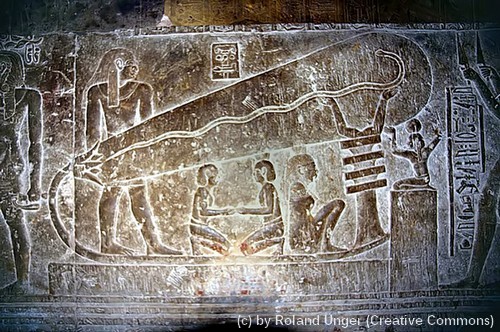
Regarding the Dendera lights: the symbolic interpretation ('scent of a lotus flower') makes sense when seen from the perspective of Egyptian culture as we know it. Egyptologists probably got most things right regarding the decyphering of hieroglyphs (based on the Rosetta stone) and the archaeology at Giza.
But does that mean their interpretation is correct? where did the concept come from that the ancient Egyptians came up with for their deities? We might be dealing with the interpretation (by Egyptologists) of an interpretation (by ancient Egyptians). What looks like the isolation of an electrical device to us is called the djed pillar which refers to the god Osiris and supposedly represents his spine'(?). And if we dig deeper, Osiris is considered to be the oldest son of the Earth god Geb and the sky goddess Nut ... etc.
The point here is that it all leads to mythological explanations and metaphysics. How do we know 'how' the Egyptians interpreted their own concepts in the first place? As long as such questions are not solved, one theory is as good as the next. If the Egyptians practiced a highly complex cargo-cult, based on the remains of an earlier civilization, the findings of Egyptologists wouldn't neccessarily be wrong. They (the ancient Egyptians) wouldn't understand the concepts of this earlier culture but still worship certain things that were important to them - while developing their own highly advanced society ... just to mention one possible & alternative scenario.
I just think that such things cannot be completely ruled out, given the contradictions we find (see sources in the OP) & the fact that it's all based on interpretations ... accordingly, and with regards to the depiction above, we might as well ask ourselves:
- Why is the scent so long & directional?
- Why does the symbol of the djed pillar look exactly like an isolation?
- Why is the pillar so distinctly 'separated' from the scent?
(...)
That's not to say it ISN'T the scent of a lotus flower, but ... well, you know!
Originally posted by Shane
We have some large scale attempt to belittle Egypt and it's people. It's been going on for 100's of years but still facts being discussed here are tell a different story.
Either that or parts of this history are really much older. What keeps surprising me is that Egyptology always has the answers, with little or no leeway for alternative interpretations ... at least so it seems!
edit on 2-7-2013 by jeep3r because: text
reply to post by jeep3r
Ok I don't have time right now to read through all of your post but one thing I will say is this, to make a bulb you need glass and glass is a very durable material...archeologists don't find glass in ancient Egypt other then maybe a few beads so the electric bulb theory is completely out of question.
Ok I don't have time right now to read through all of your post but one thing I will say is this, to make a bulb you need glass and glass is a very durable material...archeologists don't find glass in ancient Egypt other then maybe a few beads so the electric bulb theory is completely out of question.
All good arguments. It is a Crooke's tube and the Djed is a generator. And the line running from the base of the pillar travels to the back of the
anode, completing the circuit... Simple.
en.wikipedia.org...
Notice the three pics to the right at the beginning showing the bending of the electrons due to the presence of a magnet dipole? Look back at the relief showing the mother goddess with arms stretched out on both sides of the tube (hint, she represents your good ol' fashioned earth magnet. Earth goddess anyone?? She represents magnetism). The reliefs are codified knowledge.
Everything that I've discovered leads me to think we came from a much more knowledgeable civ that knocked itself back into the stone age many, many moons ago... Hence, the preservation of as much knowledge as they could in stone (and probably much more buried) while keeping that knowledge away from the masses. Keep em dumb and under control and bottleneck that info through the Egyptian priesthood so another catastrophe/war could be avoided.
en.wikipedia.org...
Notice the three pics to the right at the beginning showing the bending of the electrons due to the presence of a magnet dipole? Look back at the relief showing the mother goddess with arms stretched out on both sides of the tube (hint, she represents your good ol' fashioned earth magnet. Earth goddess anyone?? She represents magnetism). The reliefs are codified knowledge.
Everything that I've discovered leads me to think we came from a much more knowledgeable civ that knocked itself back into the stone age many, many moons ago... Hence, the preservation of as much knowledge as they could in stone (and probably much more buried) while keeping that knowledge away from the masses. Keep em dumb and under control and bottleneck that info through the Egyptian priesthood so another catastrophe/war could be avoided.
Originally posted by LUXUS
reply to post by jeep3r
archeologists don't find glass in ancient Egypt other then maybe a few beads so the electric bulb theory is completely out of question.
news.bbc.co.uk...
Ancient Egypt was mass-producing its own glass objects more than 3,000 years ago, according to evidence from digs in the country's eastern Nile delta.
The finding rejects a theory that the Egyptians simply got their glass from the Mesopotamians and reworked it.
A UK team identified the first known site from Egypt with direct evidence of "primary" glass production, meaning the Egyptians made the glass from scratch.
www.washingtonpost.com...
Analyzing glass and clay fragments at Qantir-Piramesses in the eastern Nile Delta, researchers described a two-step process in which factories melted crushed quartz to form "semifinished" glass, then re-melted and colored it to make glass "ingots" for shipment to artisans elsewhere. They melted the glass again and shaped it into inlays, ornaments and other objects.
"For years, there was no direct evidence of the production of glass," said archaeologist Thilo Rehren of University College London. "Somebody was making it, but the only thing we had were museums full of glass objects."
reply to post by jeep3r
I think this is just a case of people seeing what they think of as a familiar shape (lightbulb in this case) and they try to make it fit in with what they know about the world they live in. In other words you would be applying your knowledge to something that happened in the past and you're most likely wrong. You're in essence trying to shoot at a 2 inch target, while being spun around blindfolded and in the dark.
Do the depicitions above show something that the ancient Egyptians actually 'used' or rather something they just saw and couldn't interpret correctly? Was it just symbolic?
I think this is just a case of people seeing what they think of as a familiar shape (lightbulb in this case) and they try to make it fit in with what they know about the world they live in. In other words you would be applying your knowledge to something that happened in the past and you're most likely wrong. You're in essence trying to shoot at a 2 inch target, while being spun around blindfolded and in the dark.
reply to post by jeep3r
One thing I find interesting, is that people had the technology back then to cut stone with laser precision and drill perfect holes, using what we would call primitive tools, and there's always an ignoramus like:

Who claims it had to be aliens.
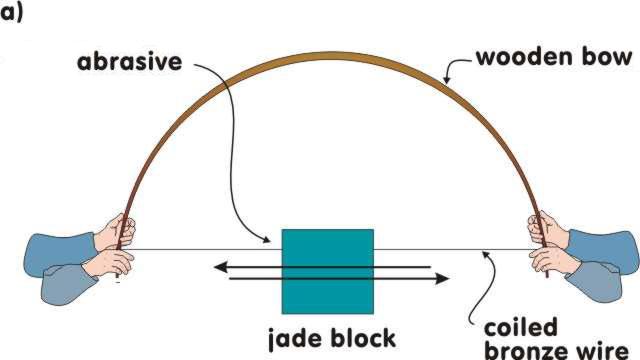
This one is a ancient Chinese bow saw. butt he Egyptians were also using this type of tech to cut stone with laser precision.

This one is an ancient Egyptian copper drill, used for drilling various sized holes, people often claim only aliens had the tech to do.
But there's nothing to indicate the pictographs at Dendera is even referring to a type of technology at all.
One thing I find interesting, is that people had the technology back then to cut stone with laser precision and drill perfect holes, using what we would call primitive tools, and there's always an ignoramus like:

Who claims it had to be aliens.

This one is a ancient Chinese bow saw. butt he Egyptians were also using this type of tech to cut stone with laser precision.

This one is an ancient Egyptian copper drill, used for drilling various sized holes, people often claim only aliens had the tech to do.
But there's nothing to indicate the pictographs at Dendera is even referring to a type of technology at all.
Originally posted by Druscilla
reply to post by jeep3r
In regard to number 1, it's a visual representation of the flower's scent:
As to the other two, there may be some possible merit to some of these investigations, though there's some large hurdles in academia that will contest these.
Out of the two others, I personally favor the Sphinx weathering and evidence collected indicating a greater age than commonly accepted as the stronger of the two alternative arguments.
Everyone needs to watch this video. It explains the carvings and disproves other things. They do not depict the scent of the flower. A good video.
reply to post by coop039
The "scent of the lotus flower" is the AA reference for the bubble.
And this is the debunker's reference:
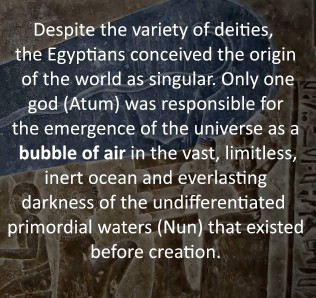
The "scent of the lotus flower" is the AA reference for the bubble.
And this is the debunker's reference:

Originally posted by lonewolf19792000
reply to post by jeep3r
One thing I find interesting, is that people had the technology back then to cut stone with laser precision and drill perfect holes, using what we would call primitive tools, and there's always an ignoramus like:
Who claims it had to be aliens.
This one is a ancient Chinese bow saw. butt he Egyptians were also using this type of tech to cut stone with laser precision.
This one is an ancient Egyptian copper drill, used for drilling various sized holes, people often claim only aliens had the tech to do.
But there's nothing to indicate the pictographs at Dendera is even referring to a type of technology at all.
I hate to break this to you but granite is far harder than jade. The main reason why some people claim aliens is because the Egyptians claim the great pyramid was built in 20 years. For them to have built this in that amount of time they had to cut, move and set one block every two and a half minutes. So it is impossible to have built it in that time frame.
Apparently the "flowers scent" is so heavy that it needs 2 arms to hold up the big end.
If it walks like a duck, and quacks like a duck, it's more than likely the aroma of some magical flower.
MOTF!
If it walks like a duck, and quacks like a duck, it's more than likely the aroma of some magical flower.
MOTF!
new topics
-
This is our Story
General Entertainment: 2 hours ago -
President BIDEN Vows to Make Americans Pay More Federal Taxes in 2025 - Political Suicide.
2024 Elections: 4 hours ago -
Ode to Artemis
General Chit Chat: 5 hours ago -
Ditching physical money
History: 9 hours ago -
One Flame Throwing Robot Dog for Christmas Please!
Weaponry: 9 hours ago -
Don't take advantage of people just because it seems easy it will backfire
Rant: 9 hours ago -
VirginOfGrand says hello
Introductions: 10 hours ago -
Should Biden Replace Harris With AOC On the 2024 Democrat Ticket?
2024 Elections: 10 hours ago
top topics
-
University student disciplined after saying veganism is wrong and gender fluidity is stupid
Education and Media: 13 hours ago, 12 flags -
Police clash with St George’s Day protesters at central London rally
Social Issues and Civil Unrest: 16 hours ago, 9 flags -
President BIDEN Vows to Make Americans Pay More Federal Taxes in 2025 - Political Suicide.
2024 Elections: 4 hours ago, 9 flags -
TLDR post about ATS and why I love it and hope we all stay together somewhere
General Chit Chat: 17 hours ago, 7 flags -
Should Biden Replace Harris With AOC On the 2024 Democrat Ticket?
2024 Elections: 10 hours ago, 6 flags -
Don't take advantage of people just because it seems easy it will backfire
Rant: 9 hours ago, 4 flags -
One Flame Throwing Robot Dog for Christmas Please!
Weaponry: 9 hours ago, 4 flags -
God lived as a Devil Dog.
Short Stories: 14 hours ago, 3 flags -
Ditching physical money
History: 9 hours ago, 3 flags -
VirginOfGrand says hello
Introductions: 10 hours ago, 2 flags
active topics
-
The Reality of the Laser
Military Projects • 33 • : ADVISOR -
Terrifying Encounters With The Black Eyed Kids
Paranormal Studies • 71 • : FlyersFan -
This is our Story
General Entertainment • 1 • : Encia22 -
whistleblower Captain Bill Uhouse on the Kingman UFO recovery
Aliens and UFOs • 17 • : vance2 -
DerBeobachter - Electric Boogaloo 2
Introductions • 13 • : DerBeobachter2 -
One Flame Throwing Robot Dog for Christmas Please!
Weaponry • 7 • : OzBiker -
University student disciplined after saying veganism is wrong and gender fluidity is stupid
Education and Media • 26 • : DerBeobachter2 -
President BIDEN Vows to Make Americans Pay More Federal Taxes in 2025 - Political Suicide.
2024 Elections • 4 • : 727Sky -
British TV Presenter Refuses To Use Guest's Preferred Pronouns
Education and Media • 128 • : Consvoli -
Tucker Carlson UFOs are piloted by spiritual entities with bases under the ocean and the ground
Aliens and UFOs • 42 • : Jukiodone
